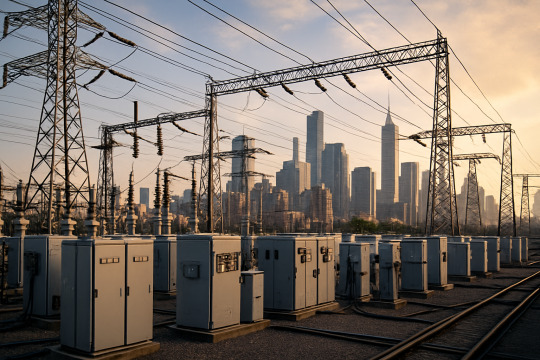#smart grid sensor
Explore tagged Tumblr posts
Text
Medium voltage support insulator manufacturers in India | radiantenterprises
Elevate your electrical solutions with Radiant Enterprises, a top name among customised insulator manufacturers in India. Specializing in high-quality epoxy insulators, we cater to the specific needs of your projects with precision and expertise. As leading medium voltage support insulator manufacturers in India, we provide durable and reliable products that meet the highest industry standards.
Trust Radiant Enterprises for innovative and customized insulator solutions designed to enhance the performance and safety of your electrical systems.
#Epoxy insulator#Customised insulator manufacturers in India#Medium voltage support insulator manufacturers in India#epoxy bushing#epoxy insulator#epoxy resin#electrical company#electrical engineering#electrical industry#fuse cutouts#smart grid sensor#rail insulator#railway technology companies#train operating companies#locomotive#tramways#metro systems#traffic infrastructure#third rail#cable connector#innovative insulators#export quality
4 notes
·
View notes
Text
Powering the Future of Railways: A Comprehensive Guide to Connectors for Railway Traction
In the context of global advancements towards sustainable and efficient transportation alternatives, there is a notable resurgence in the prominence of railways. The utilisation of railways as a primary means of transportation for both passengers and freight is on the rise, mostly due to the advantageous environmental attributes and cost-efficiency associated with this method of transport. The complex technology that drives modern railway systems is crucial for their performance, with a key element being the connectors employed for railway propulsion. Reliability you can depend upon. Elevate your railway systems with premium railway traction connectors manufactured and supplied by Radiant Enterprises - one of the distinguished Railway Traction Connectors manufacturers in India!

This thorough guide aims to provide an in-depth analysis of railway traction connectors, examining their importance, various types, advantages, and potential prospects in the future. A comprehensive grasp of these connectors is imperative for individuals engaged in the railway sector, as they assume a crucial function in propelling the advancement of trains and cultivating an environmentally friendly transportation infrastructure.
The Importance of Railway Traction Connectors:
This thorough guide aims to provide an in-depth analysis of railway traction connectors, examining their importance, various types, advantages, and potential prospects in the future. A comprehensive grasp of these connectors is imperative for individuals engaged in the railway sector, as they assume a crucial function in propelling the advancement of trains and cultivating an environmentally friendly transportation infrastructure.
Types of Railway Traction Connectors:
· Pantographs:
Pantographs represent the prevailing form of connectors employed in electric trains. The pantographs, located on the train's roof, establish a connection with the overhead wires, facilitating the transfer of electrical power to the train. Contemporary pantographs are outfitted with advanced sensors and control systems, enabling them to adjust to fluctuating voltage levels and maintain a consistent power provision.
· Third Rail Collectors:
The utilisation of a third rail as a power source is observed in certain railway systems, where trains derive electrical energy from an additional rail positioned adjacent to the tracks. Third-rail collectors are dynamic connectors that establish an electrical connection by sliding and making contact with the third rail. This approach is commonly observed in specific urban transport networks owing to its straightforwardness and economical nature.
Benefits of Advanced Railway Traction Connectors:
· Enhanced Efficiency:
Contemporary connections utilised in railway traction systems are engineered with the objective of minimising power losses during gearbox, hence leading to enhanced energy efficiency. The achievement of efficient power transmission results in a decrease in energy consumption and a reduction in operating expenses for railway operators.
· Reliability and Safety:
The utilisation of premium materials and cutting-edge engineering in the production of connectors guarantees a dependable and secure electrical linkage, hence enhancing reliability and safety. This improves the dependability and security of railway operations, hence mitigating the likelihood of power disruptions and incidents.
· Reduced Maintenance:
Connector designs that are more advanced sometimes possess self-cleaning capabilities, hence aiding in the prevention of the accumulation of dirt, debris, and ice on the contact surfaces. The implementation of this self-cleaning technology results in a reduction in maintenance demands and a decrease in downtime, hence enhancing operational availability.
· Sustainability:
The utilisation of electric trains, which are fueled by renewable energy sources, plays a substantial role in mitigating greenhouse gas emissions and addressing the issue of climate change. The utilisation of high-quality traction connectors is of paramount importance in expediting the acceptance and implementation of sustainable transportation systems.
The Future of Railway Traction Connectors:
The ongoing progress of technology will inevitably lead to the further development of railway traction connectors. Transform railway electrification with the advanced Railway Traction Connectors supplied by Radiant Enterprises. Request a sample today!
· Smart Connectivity:
The integration of the Internet of Things (IoT) and Industry 4.0 has led to the expectation that railway traction connectors will contain intelligent functionalities. The utilisation of real-time data monitoring and analytics has the potential to facilitate predictive maintenance, hence enhancing the efficiency and durability of the connectors.
· Lightweight and Durable Materials:
The field of material science has the potential to facilitate the creation of connector materials that possess both lightweight properties and exceptional durability. This may potentially result in a reduction in the overall weight of trains, hence enhancing their energy efficiency.
· High-Speed Rail:
The global demand for high-speed rail networks is experiencing a notable increase. In order to facilitate the operation of faster trains while ensuring safety and efficiency, future traction connectors will be required to accommodate elevated levels of voltage and current.
· Wireless Charging:
Wireless charging technology is now being investigated by researchers as a potential solution for trains. Potential future connectors have the potential to integrate wireless charging capabilities, hence obviating the necessity for direct physical contact between the train and the power source.
Final Thoughts:
The railway industry is positioned to assume a crucial role in influencing the trajectory of sustainable transport in the future. In order to realise this vision, the utilisation of modern technology, such as railway traction connectors, will play a pivotal role. As we progress, allocating resources towards research and development in order to create inventive and dependable connector solutions will not only propel the future of railway systems but also make a significant contribution towards a more environmentally friendly and efficient global landscape. The ongoing advancement of connector technology holds promise for the development of a more environmentally sustainable and interconnected railway system that will benefit future generations. Explore the optimal solution for your railway projects. Explore a diverse range of railway traction connectors offered by Radiant Enterprises - one of the trusted Railway Traction Connectors manufacturers in India!
#Railway Traction Connectors Manufacturers in India#Railway traction connectors#electrical#business#electrical company#electrical industry#smart grid sensor#rail insulator#railway#railway technology companies#train operating companies#locomotive#tramways#third rail#cable connector
10 notes
·
View notes
Text
Distribution Feeder Automation Market Business Research, Types and Applications, Demand by 2032
Market Overview: The Distribution Feeder Automation Market refers to the market for advanced technologies and systems that automate the monitoring, control, and management of distribution feeders within an electrical distribution network. Distribution feeder automation improves the efficiency, reliability, and resiliency of power distribution by utilizing sensors, communication networks, and automation software to monitor and control power flows, fault detection, and restoration. These solutions enhance the performance of distribution feeders and enable utilities to deliver electricity more effectively.
Feeder Automation Market is projected to be worth USD 7.85 Billion by 2030, registering a CAGR of 8.2% during the forecast period (2022 - 2030)
Demand: The demand for distribution feeder automation is driven by several factors, including:
Distribution feeder automation solutions help utilities improve the reliability and resiliency of their distribution networks. By automating fault detection, isolation, and restoration, these systems minimize outage durations and enhance the overall performance of the grid, ensuring a more reliable power supply for customers.
Distribution feeder automation systems streamline operations by reducing manual interventions, optimizing power flow, and enhancing network monitoring capabilities. These solutions enable utilities to manage distribution feeders more efficiently, reduce costs, and improve the overall operational performance of their networks.
The increasing integration of renewable energy sources, such as solar and wind power, into the distribution grid presents operational challenges. Distribution feeder automation helps utilities manage the intermittent nature of renewables, optimize power flow, and ensure grid stability, facilitating the integration of clean energy sources.
Latest technological developments, key factors, and challenges in the Distribution Feeder Automation Market:
Latest Technological Developments:
Intelligent Sensors and IoT Integration: Distribution feeder automation is leveraging intelligent sensors and Internet of Things (IoT) integration to monitor real-time data from various points along the distribution feeders. These sensors provide insights into voltage levels, current flow, fault detection, and other parameters, enabling quicker fault localization and resolution.
Advanced Communication Protocols: Modern distribution feeder automation systems are adopting advanced communication protocols like for seamless data exchange between field devices and control centers. This facilitates real-time monitoring, remote control, and efficient data transmission.
Decentralized Control and Edge Computing: Distribution feeder automation systems are moving toward decentralized control and edge computing. This allows decision-making and control to occur closer to field devices, reducing latency and enhancing responsiveness.
Distributed Energy Resource (DER) Management: With the integration of distributed energy resources like solar panels, wind turbines, and energy storage systems, feeder automation systems are being developed to manage these resources effectively, ensuring grid stability and optimal energy distribution.
Advanced Analytics and AI: Distribution feeder automation is incorporating advanced analytics and artificial intelligence to analyze data from various sources. AI algorithms can predict and prevent potential faults, optimize energy flows, and enhance overall feeder performance.
Key Factors:
Reliability Enhancement: Distribution feeder automation improves the reliability of electricity distribution by enabling quicker fault detection, isolation, and restoration. This minimizes outage durations and enhances overall grid reliability.
Efficient Grid Management: Feeder automation allows utilities to manage the distribution grid more efficiently. Load balancing, voltage regulation, and fault management can be automated, leading to optimized energy delivery.
Integration of Renewable Energy: As the penetration of renewable energy sources increases, distribution feeder automation becomes crucial for managing the intermittent nature of these resources and maintaining grid stability.
Grid Resilience and Outage Management: Feeder automation systems enhance grid resilience by providing real-time data on grid conditions and faults. This facilitates faster response and restoration during outages, minimizing customer impact.
Challenges:
Interoperability: Integrating various devices and protocols into a cohesive feeder automation system can be challenging due to the need for interoperability between different vendors and technologies.
Cybersecurity: With increased connectivity and data exchange, distribution feeder automation systems face cybersecurity threats. Ensuring the security of these systems is paramount to prevent unauthorized access and data breaches.
Cost and Infrastructure: Implementing distribution feeder automation can involve significant upfront costs, including hardware, software, and training. Retrofitting existing infrastructure for automation may also pose challenges.
Complexity of Data Management: Feeder automation generates vast amounts of data that need to be effectively managed, analyzed, and acted upon. Handling this complexity can be demanding.
Change Management: Transitioning from manual to automated processes requires change management efforts to train personnel, address resistance, and ensure smooth integration.
Maintenance and Upgrades: Ensuring the proper functioning of feeder automation systems over time requires regular maintenance and potential upgrades to keep up with technology advancements.
Distribution feeder automation is at the forefront of modernizing electricity distribution networks. While it offers significant benefits in terms of reliability, efficiency, and resilience, addressing technical challenges and ensuring a smooth transition is crucial for successful implementation.
By visiting our website or contacting us directly, you can explore the availability of specific reports related to this market. These reports often require a purchase or subscription, but we provide comprehensive and in-depth information that can be valuable for businesses, investors, and individuals interested in this market.
“Remember to look for recent reports to ensure you have the most current and relevant information.”
Click Here, To Get Free Sample Report: https://stringentdatalytics.com/sample-request/distribution-automation-solutions-market/10965/
Market Segmentations:
Global Distribution Feeder Automation Market: By Company
• ABB
• Eaton
• Grid Solutions
• Schneider Electric
• Siemens
• Advanced Control Systems
• Atlantic City Electric
• CG
• G&W Electric
• Kalkitech
• Kyland Technology
• Moxa
• S&C Electric Company
• Schweitzer Engineering Laboratories (SEL)
Global Distribution Feeder Automation Market: By Type
• Fault Location
• Isolation
• Service Restoration
• Automatic Transfer Scheme
Global Distribution Feeder Automation Market: By Application
• Industrial
• Commercial
• Residential
Global Distribution Feeder Automation Market: Regional Analysis
The regional analysis of the global Distribution Feeder Automation market provides insights into the market's performance across different regions of the world. The analysis is based on recent and future trends and includes market forecast for the prediction period. The countries covered in the regional analysis of the Distribution Feeder Automation market report are as follows:
North America: The North America region includes the U.S., Canada, and Mexico. The U.S. is the largest market for Distribution Feeder Automation in this region, followed by Canada and Mexico. The market growth in this region is primarily driven by the presence of key market players and the increasing demand for the product.
Europe: The Europe region includes Germany, France, U.K., Russia, Italy, Spain, Turkey, Netherlands, Switzerland, Belgium, and Rest of Europe. Germany is the largest market for Distribution Feeder Automation in this region, followed by the U.K. and France. The market growth in this region is driven by the increasing demand for the product in the automotive and aerospace sectors.
Asia-Pacific: The Asia-Pacific region includes Singapore, Malaysia, Australia, Thailand, Indonesia, Philippines, China, Japan, India, South Korea, and Rest of Asia-Pacific. China is the largest market for Distribution Feeder Automation in this region, followed by Japan and India. The market growth in this region is driven by the increasing adoption of the product in various end-use industries, such as automotive, aerospace, and construction.
Middle East and Africa: The Middle East and Africa region includes Saudi Arabia, U.A.E, South Africa, Egypt, Israel, and Rest of Middle East and Africa. The market growth in this region is driven by the increasing demand for the product in the aerospace and defense sectors.
South America: The South America region includes Argentina, Brazil, and Rest of South America. Brazil is the largest market for Distribution Feeder Automation in this region, followed by Argentina. The market growth in this region is primarily driven by the increasing demand for the product in the automotive sector.
Click Here, To Buy Report: https://stringentdatalytics.com/purchase/distribution-feeder-automation-market/10966/?license=single
Reasons to Purchase Distribution Feeder Automation Market Report:
Comprehensive Market Insights: Global research market reports provide a thorough and in-depth analysis of a specific market or industry. They offer valuable insights into market size, growth potential, trends, challenges, and opportunities, helping businesses make informed decisions and formulate effective strategies.
Market Analysis and Forecasts: These reports provide detailed analysis and forecasts of market trends, growth rates, and future market scenarios. They help businesses understand the current market landscape and anticipate future market developments, enabling them to plan and allocate resources accordingly.
Competitive Intelligence: Global research market reports provide a competitive landscape analysis, including information about key market players, their market share, strategies, and product portfolios. This information helps businesses understand their competitors' strengths and weaknesses, identify market gaps, and develop strategies to gain a competitive advantage.
Industry Trends and Insights: These reports offer insights into industry-specific trends, emerging technologies, and regulatory frameworks. Understanding industry dynamics and staying updated on the latest trends can help businesses identify growth opportunities and stay ahead in a competitive market.
Investment and Expansion Opportunities: Global research market reports provide information about investment opportunities, potential markets for expansion, and emerging growth areas. These reports help businesses identify untapped markets, assess the feasibility of investments, and make informed decisions regarding expansion strategies.
Risk Mitigation: Market reports provide risk assessment and mitigation strategies. By analyzing market dynamics, potential challenges, and regulatory frameworks, businesses can proactively identify risks and develop strategies to mitigate them, ensuring better risk management and decision-making.
Cost and Time Efficiency: Conducting comprehensive market research independently can be time-consuming and expensive. Purchasing a global research market report provides a cost-effective and time-efficient solution, saving businesses valuable resources while still gaining access to reliable and detailed market information.
Decision-Making Support: Global research market reports serve as decision-making tools by providing data-driven insights and analysis. Businesses can rely on these reports to support their decision-making process, validate assumptions, and evaluate the potential outcomes of different strategies.
In general, market research studies offer companies and organisations useful data that can aid in making decisions and maintaining competitiveness in their industry. They can offer a strong basis for decision-making, strategy formulation, and company planning.
About US:
Stringent Datalytics offers both custom and syndicated market research reports. Custom market research reports are tailored to a specific client's needs and requirements. These reports provide unique insights into a particular industry or market segment and can help businesses make informed decisions about their strategies and operations.
Syndicated market research reports, on the other hand, are pre-existing reports that are available for purchase by multiple clients. These reports are often produced on a regular basis, such as annually or quarterly, and cover a broad range of industries and market segments. Syndicated reports provide clients with insights into industry trends, market sizes, and competitive landscapes. By offering both custom and syndicated reports, Stringent Datalytics can provide clients with a range of market research solutions that can be customized to their specific needs
Contact US:
Stringent Datalytics
Contact No - +1 346 666 6655
Email Id - [email protected]
Web - https://stringentdatalytics.com/
#Distribution Feeder Automation#Smart Grid Technology#Intelligent Sensors#IoT Integration#Edge Computing#Advanced Analytics#AI in Grid Management#Microgrid Integration#Fault Detection#Voltage Regulation#Load Balancing#Power Distribution Optimization#Grid Resilience#Outage Management#Renewable Energy Integration#Distribution System Efficiency#Energy Management Solutions.
0 notes
Text
Innovations in Electrical Switchgear: What’s New in 2025?

The electrical switchgear industry is undergoing a dynamic transformation in 2025, fueled by the rapid integration of smart technologies, sustainability goals, and the growing demand for reliable power distribution systems. As a key player in modern infrastructure — whether in industrial plants, commercial facilities, or utilities — switchgear systems are becoming more intelligent, efficient, and future-ready.
At Almond Enterprise, we stay ahead of the curve by adapting to the latest industry innovations. In this blog, we’ll explore the most exciting developments in electrical switchgear in 2025 and what they mean for businesses, contractors, and project engineers.
Rise of Smart Switchgear
Smart switchgear is no longer a futuristic concept — it’s a necessity in 2025. These systems come equipped with:
IoT-based sensors
Real-time data monitoring
Remote diagnostics and control
Predictive maintenance alerts
This technology allows for remote management, helping facility managers reduce downtime, minimize energy losses, and detect issues before they become critical. At Almond Enterprise, we supply and support the integration of smart switchgear systems that align with Industry 4.0 standards.
2. Focus on Eco-Friendly and SF6-Free Alternatives
Traditional switchgear often relies on SF₆ gas for insulation, which is a potent greenhouse gas. In 2025, there’s a significant shift toward sustainable switchgear, including:
Vacuum Interrupter technology
Air-insulated switchgear (AIS)
Eco-efficient gas alternatives like g³ (Green Gas for Grid)
These options help organizations meet green building codes and corporate sustainability goals without compromising on performance.
3. Wireless Monitoring & Cloud Integration
Cloud-based platforms are transforming how switchgear systems are managed. The latest innovation includes:
Wireless communication protocols like LoRaWAN and Zigbee
Cloud dashboards for real-time visualization
Integration with Building Management Systems (BMS)
This connectivity enhances control, ensures quicker fault detection, and enables comprehensive energy analytics for large installations
4. AI and Machine Learning for Predictive Maintenance
Artificial Intelligence is revolutionizing maintenance practices. Switchgear in 2025 uses AI algorithms to:
Predict component failure
Optimize load distribution
Suggest optimal switchgear settings
This reduces unplanned outages, increases safety, and extends equipment life — particularly critical for mission-critical facilities like hospitals and data centers.
5. Enhanced Safety Features and Arc Flash Protection
With increasing focus on workplace safety, modern switchgear includes:
Advanced arc flash mitigation systems
Thermal imaging sensors
Remote racking and switching capabilities
These improvements ensure safer maintenance and operation, protecting personnel from high-voltage hazards.
6. Modular & Scalable Designs
Gone are the days of bulky, rigid designs. In 2025, switchgear units are:
Compact and modular
Easier to install and expand
Customizable based on load requirements
Almond Enterprise supplies modular switchgear tailored to your site’s unique needs, making it ideal for fast-paced infrastructure developments and industrial expansions.
7. Global Standardization and Compliance
As global standards evolve, modern switchgear must meet new IEC and IEEE guidelines. Innovations include:
Improved fault current limiting technologies
Higher voltage and current ratings with compact dimensions
Compliance with ISO 14001 for environmental management
Our team ensures all equipment adheres to the latest international regulations, providing peace of mind for consultants and project managers.
Final Thoughts: The Future is Electric
The switchgear industry in 2025 is smarter, safer, and more sustainable than ever. For companies looking to upgrade or design new power distribution systems, these innovations offer unmatched value.
At Almond Enterprise, we don’t just supply electrical switchgear — we provide expert solutions tailored to tomorrow’s energy challenges. Contact us today to learn how our cutting-edge switchgear offerings can power your future projects.
5 notes
·
View notes
Text
Building Safer Cities: How Advanced Switchgear Is Powering the Future

Switchgear refers to the combination of electrical disconnect switches, fuses, and circuit breakers used to control, protect, and isolate electrical equipment. In simple words: it’s the shield that protects the power network from overloads, faults, and blackouts.
Without high-quality switchgear, cities would face:
· Frequent power failures
· Increased risk of electrical fires
· Equipment damage
· Unsafe environments for residents and businesses
In today’s urban landscape, switchgear isn’t just an accessory — it’s a critical lifeline for energy security and public safety.
How Advanced Switchgear is Shaping Safer Cities
Thanks to major technological advancements, switchgear is no longer static and reactive. Modern switchgear systems are smart, dynamic, and preventative. Here’s how they are transforming cities:
1. Real-Time Monitoring and Fault Detection
Smart switchgear comes equipped with IoT sensors and digital monitoring systems that detect faults in real time. Instead of waiting for a catastrophic failure, the system identifies weak points early — enabling quick, preventive maintenance.
Impact: Reduced blackouts, faster repair times, safer living and working environments.
2. Automated Shutdowns During Emergencies
In critical events like fires, short circuits, or system overloads, automated switchgear can instantly isolate the affected section. This targeted shutdown prevents the spread of danger and keeps the rest of the city powered.
👉 Impact: Enhanced public safety, minimized risk of widespread outages.
3. Supporting Renewable Energy Integration
As cities shift toward renewable energy sources (solar, wind, hydro), modern switchgear is designed to handle these variable inputs seamlessly. It balances load fluctuations and ensures grid stability, even when energy production varies hour by hour.
👉 Impact: Cleaner cities without sacrificing reliability.
4. Enhanced Energy Efficiency
Advanced switchgear minimizes energy losses during transmission and distribution. With features like optimized load management and energy analytics, cities can operate their power grids more sustainably and economically.
👉 Impact: Lower energy costs, greener urban spaces.
Why Upgrading Switchgear is Essential for the Cities of Tomorrow
The future city will be:
· More populated
· More digitalized
· More energy-demanding
Legacy power systems cannot keep up with this growth. Old switchgear is more vulnerable to faults, inefficiency, and even cyberattacks. Modern, advanced switchgear not only provides higher protection but also future-proofs cities against evolving challenges.
Investing in advanced switchgear means investing in:
· Public safety
· Economic stability
· Environmental responsibility
· Smart infrastructure development
Conclusion: Powering a Safer, Smarter Future
As we envision smarter, greener, and safer cities, we must pay attention to the systems that keep the lights on — and keep people safe. Advanced switchgear stands at the front line of this transformation, quietly ensuring that progress doesn’t come at the cost of safety.
Whether you’re an urban planner, an electrical engineer, or a business owner — prioritizing the right switchgear solutions is key to building cities ready for the challenges of tomorrow.
Looking for world-class switchgear products and accessories? Al Taqwa Electrical and Building Materials offers cutting-edge solutions trusted by industries across the world.
#electrical#electrical equipment#electrical supplies#building#building materials#oman#muscat#switchgear
2 notes
·
View notes
Text
Smart Switchgear in 2025: What Electrical Engineers Need to Know

In the fast-evolving world of electrical infrastructure, smart switchgear is no longer a futuristic concept — it’s the new standard. As we move through 2025, the integration of intelligent systems into traditional switchgear is redefining how engineers design, monitor, and maintain power distribution networks.
This shift is particularly crucial for electrical engineers, who are at the heart of innovation in sectors like manufacturing, utilities, data centers, commercial construction, and renewable energy.
In this article, we’ll break down what smart switchgear means in 2025, the technologies behind it, its benefits, and what every electrical engineer should keep in mind.
What is Smart Switchgear?
Smart switchgear refers to traditional switchgear (devices used for controlling, protecting, and isolating electrical equipment) enhanced with digital technologies, sensors, and communication modules that allow:
Real-time monitoring
Predictive maintenance
Remote operation and control
Data-driven diagnostics and performance analytics
This transformation is powered by IoT (Internet of Things), AI, cloud computing, and edge devices, which work together to improve reliability, safety, and efficiency in electrical networks.
Key Innovations in Smart Switchgear (2025 Edition)
1. IoT Integration
Smart switchgear is equipped with intelligent sensors that collect data on temperature, current, voltage, humidity, and insulation. These sensors communicate wirelessly with central systems to provide real-time status and alerts.
2. AI-Based Predictive Maintenance
Instead of traditional scheduled inspections, AI algorithms can now predict component failure based on usage trends and environmental data. This helps avoid downtime and reduces maintenance costs.
3. Cloud Connectivity
Cloud platforms allow engineers to remotely access switchgear data from any location. With user-friendly dashboards, they can visualize key metrics, monitor health conditions, and set thresholds for automated alerts.
4. Cybersecurity Enhancements
As devices get connected to networks, cybersecurity becomes crucial. In 2025, smart switchgear is embedded with secure communication protocols, access control layers, and encrypted data streams to prevent unauthorized access.
5. Digital Twin Technology
Some manufacturers now offer a digital twin of the switchgear — a virtual replica that updates in real-time. Engineers can simulate fault conditions, test load responses, and plan future expansions without touching the physical system.
Benefits for Electrical Engineers
1. Operational Efficiency
Smart switchgear reduces manual inspections and allows remote diagnostics, leading to faster response times and reduced human error.
2. Enhanced Safety
Early detection of overload, arc flash risks, or abnormal temperatures enhances on-site safety, especially in high-voltage environments.
3. Data-Driven Decisions
Real-time analytics help engineers understand load patterns and optimize distribution for efficiency and cost savings.
4. Seamless Scalability
Modular smart systems allow for quick expansion of power infrastructure, particularly useful in growing industrial or smart city projects.
Applications Across Industries
Manufacturing Plants — Monitor energy use per production line
Data Centers — Ensure uninterrupted uptime and cooling load balance
Commercial Buildings — Integrate with BMS (Building Management Systems)
Renewable Energy Projects — Balance grid load from solar or wind sources
Oil & Gas Facilities — Improve safety and compliance through monitoring
What Engineers Need to Know Moving Forward
1. Stay Updated with IEC & IEEE Standards
Smart switchgear must comply with global standards. Engineers need to be familiar with updates related to IEC 62271, IEC 61850, and IEEE C37 series.
2. Learn Communication Protocols
Proficiency in Modbus, DNP3, IEC 61850, and OPC UA is essential to integrating and troubleshooting intelligent systems.
3. Understand Lifecycle Costing
Smart switchgear might have a higher upfront cost but offers significant savings in maintenance, energy efficiency, and downtime over its lifespan.
4. Collaborate with IT Teams
The line between electrical and IT is blurring. Engineers should work closely with cybersecurity and cloud teams for seamless, secure integration.
Conclusion
Smart switchgear is reshaping the way electrical systems are built and managed in 2025. For electrical engineers, embracing this innovation isn’t just an option — it’s a career necessity.
At Blitz Bahrain, we specialize in providing cutting-edge switchgear solutions built for the smart, digital future. Whether you’re an engineer designing the next big project or a facility manager looking to upgrade existing systems, we’re here to power your progress.
#switchgear#panel#manufacturer#bahrain25#electrical supplies#electrical equipment#electrical engineers#electrical
5 notes
·
View notes
Text
What is artificial intelligence (AI)?

Imagine asking Siri about the weather, receiving a personalized Netflix recommendation, or unlocking your phone with facial recognition. These everyday conveniences are powered by Artificial Intelligence (AI), a transformative technology reshaping our world. This post delves into AI, exploring its definition, history, mechanisms, applications, ethical dilemmas, and future potential.
What is Artificial Intelligence? Definition: AI refers to machines or software designed to mimic human intelligence, performing tasks like learning, problem-solving, and decision-making. Unlike basic automation, AI adapts and improves through experience.
Brief History:
1950: Alan Turing proposes the Turing Test, questioning if machines can think.
1956: The Dartmouth Conference coins the term "Artificial Intelligence," sparking early optimism.
1970s–80s: "AI winters" due to unmet expectations, followed by resurgence in the 2000s with advances in computing and data availability.
21st Century: Breakthroughs in machine learning and neural networks drive AI into mainstream use.
How Does AI Work? AI systems process vast data to identify patterns and make decisions. Key components include:
Machine Learning (ML): A subset where algorithms learn from data.
Supervised Learning: Uses labeled data (e.g., spam detection).
Unsupervised Learning: Finds patterns in unlabeled data (e.g., customer segmentation).
Reinforcement Learning: Learns via trial and error (e.g., AlphaGo).
Neural Networks & Deep Learning: Inspired by the human brain, these layered algorithms excel in tasks like image recognition.
Big Data & GPUs: Massive datasets and powerful processors enable training complex models.
Types of AI
Narrow AI: Specialized in one task (e.g., Alexa, chess engines).
General AI: Hypothetical, human-like adaptability (not yet realized).
Superintelligence: A speculative future AI surpassing human intellect.
Other Classifications:
Reactive Machines: Respond to inputs without memory (e.g., IBM’s Deep Blue).
Limited Memory: Uses past data (e.g., self-driving cars).
Theory of Mind: Understands emotions (in research).
Self-Aware: Conscious AI (purely theoretical).
Applications of AI
Healthcare: Diagnosing diseases via imaging, accelerating drug discovery.
Finance: Detecting fraud, algorithmic trading, and robo-advisors.
Retail: Personalized recommendations, inventory management.
Manufacturing: Predictive maintenance using IoT sensors.
Entertainment: AI-generated music, art, and deepfake technology.
Autonomous Systems: Self-driving cars (Tesla, Waymo), delivery drones.
Ethical Considerations
Bias & Fairness: Biased training data can lead to discriminatory outcomes (e.g., facial recognition errors in darker skin tones).
Privacy: Concerns over data collection by smart devices and surveillance systems.
Job Displacement: Automation risks certain roles but may create new industries.
Accountability: Determining liability for AI errors (e.g., autonomous vehicle accidents).
The Future of AI
Integration: Smarter personal assistants, seamless human-AI collaboration.
Advancements: Improved natural language processing (e.g., ChatGPT), climate change solutions (optimizing energy grids).
Regulation: Growing need for ethical guidelines and governance frameworks.
Conclusion AI holds immense potential to revolutionize industries, enhance efficiency, and solve global challenges. However, balancing innovation with ethical stewardship is crucial. By fostering responsible development, society can harness AI’s benefits while mitigating risks.
2 notes
·
View notes
Text
Essential Skills Every Electronics Engineer Should Master
Electronics engineering is an exciting and constantly evolving field. With new technologies emerging every day, the need for skilled professionals has never been greater. If you're pursuing a B Tech in Electrical and Electronics Engineering or exploring options at B Tech colleges for Electrical and Electronics, it's crucial to know which skills can set you apart in this competitive domain.
Let’s dive into the essential skills every aspiring electronics engineer should master.
Strong Foundation in Circuit Design
Circuit design is at the heart of electronics engineering. Understanding how to create, analyze, and optimize circuits is a must-have skill. Whether you’re designing a simple resistor network or a complex integrated circuit, mastering tools like SPICE and PCB design software can make your designs efficient and innovative.
Programming Proficiency
Electronics and programming often go hand in hand. Languages like Python, C, and MATLAB are widely used to simulate electronic systems, automate processes, and even build firmware for devices. Engineers proficient in programming can troubleshoot problems effectively and add versatility to their skill set.
Knowledge of Embedded Systems
Embedded systems are everywhere—from your smartphone to your washing machine. As an electronics engineer, understanding microcontrollers, sensors, and actuators is crucial for creating devices that work seamlessly in our daily lives. Hands-on experience with platforms like Arduino and Raspberry Pi can be a great way to start.
Problem-Solving and Analytical Thinking
Electronics engineers often face unique challenges, such as debugging faulty circuits or improving system performance. Strong problem-solving and analytical thinking skills help them identify issues quickly and find effective solutions. To cultivate these skills, tackle real-world projects during your coursework or internships.
Familiarity with Power Systems
As the world moves toward renewable energy and smart grids, knowledge of power systems is becoming increasingly important. Engineers in this field should understand how electrical power is generated, transmitted, and distributed and how to design energy-efficient systems.
Effective Communication Skills
Electronics engineering often involves working in teams with other engineers, designers, or clients. Communicating your ideas clearly—whether through reports, presentations, or technical drawings—is just as important as your technical skills. Strong communication ensures that your brilliant ideas come to life effectively.
Adaptability to New Technologies
Technology evolves rapidly, and staying updated is essential for electronics engineers. Whether you’re learning about IoT (Internet of Things), AI integration, or 5G communication, an adaptable mindset will ensure you remain relevant and capable of tackling emerging challenges.
Hands-On Experience
While theoretical knowledge is important, nothing beats practical experience. Participating in labs, internships, or personal projects gives you the opportunity to apply what you’ve learned and develop confidence in your skills. Employers often value hands-on experience as much as your academic achievements.
Preparing for Success in Electronics Engineering
Pursuing a B Tech in Electrical and Electronics Engineering is the first step toward mastering these skills. The best B Tech colleges for Electrical and Electronics not only provide a strong academic foundation but also opportunities for practical learning and industry exposure. By focusing on the skills mentioned above, you can position yourself as a competent and innovative engineer ready to tackle real-world challenges.
3 notes
·
View notes
Text
Why the Low Voltage Switchgear Market is Booming in 2025?

The low voltage switchgear market is growing rapidly in 2025 due to growth in electricity consumption, development of intelligent devices, and a strong emphasis on sustainability. Energy efficiency, digital transformation, and security are critical for industries and businesses, which leads to a high demand for new, robust, and intelligent switchgear. This article will discuss key drivers of market growth, emerging trends, and their impact on businesses and industries globally.
1. The Growing Demand for Electricity
Over the past few decades, the increasing demand for efficiency in power distribution systems has become ever imminent with the rise of general energy consumption. Rapid urban expansion, industrial development, and the emergence of data centers have been some of the major driving forces boosting the demand for low-voltage switchgear.
Global Electricity Demand on the Rise:
· The IEA projects electricity demand in developing nations will rise at a rate of 4% each year, as consumption steadily climbs.
· Data facilities and cloud computing require relentless power sources, amplifying the need for resilient switching equipment solutions capable of sustaining operations.
· The proliferation of electric vehicle charging points is compelling utilities to renovate distribution networks, ensuring functionality can accommodate increased demand.
Modernization spreads as industries broaden their scope, making electrically-reliable infrastructure an imperative; low voltage switchgear has become integral to conveying energy throughout the grid in a secure and effective manner.
2. Smart & Digital Switchgear: The Industry’s Future
Traditional switchgear technology has evolved rapidly with the integration of intelligent networking capabilities, making electrical distribution safer, more efficient, and easier to monitor remotely. The new digital switchgear incorporates IoT, AI, and cloud-based monitoring solutions to provide real-time insight into energy usage. This allows businesses to proactively optimize performance and reduce costs through more proactive maintenance strategies.
Major Developments in Intelligent Switchgear by 2025:
✅Online Sensor Networks: Constant telemetry from devices throughout the system helps pinpoint potential weaknesses before failures occur.
✅Self-learning Circuitry: AI-powered hardware and software automatically analyze usage patterns to forecast repairs, minimize outages, and heighten uptime.
✅Wireless Remote Management: Mobile apps and web dashboards give administrators off-site control over power flows to streamline usage according to need.
✅Modular Construction: Interchangeable, compact components facilitate scaling and retrofitting within varied infrastructure environments.
The shift toward automated smart grids and Industry 4.0 production is substantially contributing to the booming market for intelligent switchgear solutions. Widespread installation of these next-generation systems will transform electrical distribution networks.
3. Rising Emphasis on Energy Efficiency & Sustainability
Governments and industries worldwide have increasingly pushed for greener, more energy-efficient power solutions in recent years. This has led electrical equipment manufacturers to develop eco-friendly switchgear technologies that considerably minimize energy loss during transmission and help reduce overall carbon footprints.
Sustainable Advancements in Low Voltage Switchgear Design:
Alternative gases to SF6: Traditional switchgear commonly uses SF6 due to its insulating and arc-quenching capabilities, however this gas has an extremely high global warming potential. Many switchgear producers have since designed SF6-free solutions that substitute the highly potent SF6 with other gases that are safer for the environment.
Energy-Efficient Designs: Optimizing circuitry and components has allowed switchgear to conduct electricity with negligible power loss, enabling connected systems to leverage nearly every watt of power. Careful engineering further trims excess material use and redundant parts.
Renewable Energy Integration: Low voltage switchgear has become increasingly vital in smoothly and reliably integrating power from solar arrays and wind farms into existing electrical networks. Without robust switchgear management, it would be difficult for clean energy sources to efficiently feed power onto transmission lines.
With the implementation of more stringent energy performance mandates in countries worldwide, businesses have sound business reasons for upgrading outdated switchgear infrastructure with advanced low loss solutions both to adhere to regulations and lower long-term energy expenditures.
4. Increasing Investments in Infrastructure & Industrialization
Governments and private investors alike are pouring billions into ambitious infrastructure projects around the world, generating skyrocketing demand for reliable low voltage switchgear solutions. From towering commercial skyscrapers to sprawling industrial complexes, and expanding metro networks to bustling international airports — countless utilities depend on robust yet cost-effective switching systems to ensure continuity of operations.
🔹 Key Infrastructure Drivers Stimulating Growth:
🏗️ Smart Cities Uplift Life: Sweeping investments in digital urbanization are revolutionizing everyday living through connected infrastructure that elevates efficiency.
��� Manufacturing Marvels: Production powerhouses across the globe are scaling new heights, intensifying the necessity for advanced low voltage distribution controls to support increased capacity.
🚆 Transportation Transformations: Rapid progress in rail electrification and proliferation of electric vehicles for land and air are necessitating increasingly resilient switchgear designs.
As global development marches forth, low voltage switchgear has become mission critical in enabling commercial and industrial progress through reliable power distribution. The worldwide infrastructure renaissance is cementing its importance for years to come.
5. Safety & Regulatory Compliance Are Driving Upgrades
Governments and regulatory bodies are increasingly implementing strict compliance standards to safeguard electrical infrastructure and minimize hazards, compelling upgrades across many industries. Potential calamities resulting from power faults or failures necessitate vigilance in maintaining reliable and resilient systems.
New Safety Regulations in 2025:
⚡ Updated IEC & NEC Standards: Stringent low voltage switchgear specifications mandated to bolster protection.
⚡ Arc Fault Protection Technology: Novel solutions critical to curb risks of electrical ignitions and incidents.
⚡ Mandatory Energy Audits: Organizations now required to optimize distribution for both personnel and operational efficiency through audits.
With approaching deadlines to satisfy evolving regulations, operators are proactively replacing outdated switchgear to conform with mounting compliance demands, contributing to an accelerating industry transformation.
6. The Rise of Data Centers & Digital Transformation
The digital sphere fundamentally relies upon data hubs that necessitate constant power and exceedingly reliable electric frameworks. As distributed computing, man-made brainpower, and IoT reception develop exponentially, ventures are putting vigorously in cutting edge low voltage switches to ensure their foundation from energy blackouts which could bring about gigantic budgetary misfortunes.
24/7 control is essential for operations yet breakdowns prompt critical money related setbacks. To guarantee uptime, focal points utilize auxiliary switches for extra dependability and security alongside far off checking abilities through IoT innovations which empower ongoing following and administration from anywhere. With worldwide distributed computing selection quickening at a quickening pace, interest for top notch low voltage switches arriving at new statures to guarantee frameworks stay online consistently.
7. Competitive Market & Technological Advancements
The low voltage switchgear sector has seen remarkable changes and fierce competition between prestigious brands. Manufacturers are pouring resources into innovation to craft smarter, smaller, and affordable switchboard alternatives.
🔹 Notable Advancements by 2025:
⚙️ Solid-state systems promise enhanced performance and lessened upkeep. Long and compound sentences mix with short ones.
⚙️ Remote accessibility through wireless means permits control and tracking from afar.
⚙️ Self-mending grids using AI to immediately spot and amend problems, maintaining dependable power seamlessly. Complex automation alleviates faults autonomously for maximum uptime.
Conclusion: The Future of Low Voltage Switchgear Looks Bright
Low Voltage Switchgear is forecasted to experience market growth in the year 2025 due to the growing electricity consumption in countries, the rising applications of smart technologies, the increased implementation of sustainability practices, the expansive growth in various industries, and safety regulations. As these industries are gradually moving to energy-efficient, AI-powered, and environmentally friendly switchgears, this demand is expected to increase further.
4 notes
·
View notes
Text

A new and unique fusion reactor comes together due to global research collaboration
Like atoms coming together to release their power, fusion researchers worldwide are joining forces to solve the world's energy crisis. Harnessing the power of fusing plasma as a reliable energy source for the power grid is no easy task, requiring global contributions.
The Princeton Plasma Physics Laboratory (PPPL) is leading several efforts on this front, including collaborating on the design and development of a new fusion device at the University of Seville in Spain. The SMall Aspect Ratio Tokamak (SMART) strongly benefits from PPPL computer codes as well as the Lab's expertise in magnetics and sensor systems.
"The SMART project is a great example of us all working together to solve the challenges presented by fusion and teaching the next generation what we have already learned," said Jack Berkery, PPPL's deputy director of research for the National Spherical Torus Experiment-Upgrade (NSTX-U) and principal investigator for the PPPL collaboration with SMART. "We have to all do this together or it's not going to happen."
Manuel Garcia-Munoz and Eleonora Viezzer, both professors at the Department of Atomic, Molecular and Nuclear Physics of the University of Seville as well as co-leaders of the Plasma Science and Fusion Technology Lab and the SMART tokamak project, said PPPL seemed like the ideal partner for their first tokamak experiment. The next step was deciding what kind of tokamak they should build.
"It needed to be one that a university could afford but also one that could make a unique contribution to the fusion landscape at the university scale," said Garcia-Munoz. "The idea was to put together technologies that were already established: a spherical tokamak and negative triangularity, making SMART the first of its kind. It turns out it was a fantastic idea."
SMART should offer easy-to-manage fusion plasma
Triangularity refers to the shape of the plasma relative to the tokamak. The cross section of the plasma in a tokamak is typically shaped like the capital letter D. When the straight part of the D faces the center of the tokamak, it is said to have positive triangularity. When the curved part of the plasma faces the center, the plasma has negative triangularity.
Garcia-Munoz said negative triangularity should offer enhanced performance because it can suppress instabilities that expel particles and energy from the plasma, preventing damage to the tokamak wall.
"It's a potential game changer with attractive fusion performance and power handling for future compact fusion reactors," he said. "Negative triangularity has a lower level of fluctuations inside the plasma, but it also has a larger divertor area to distribute the heat exhaust."
The spherical shape of SMART should make it better at confining the plasma than it would be if it were doughnut shaped. The shape matters significantly in terms of plasma confinement. That is why NSTX-U, PPPL's main fusion experiment, isn't squat like some other tokamaks: the rounder shape makes it easier to confine the plasma. SMART will be the first spherical tokamak to fully explore the potential of a particular plasma shape known as negative triangularity.
PPPL's expertise in computer codes proves essential
PPPL has a long history of leadership in spherical tokamak research. The University of Seville fusion team first contacted PPPL to implement SMART in TRANSP, a simulation software developed and maintained by the Lab. Dozens of facilities use TRANSP, including private ventures such as Tokamak Energy in England.
"PPPL is a world leader in many, many areas, including fusion simulation; TRANSP is a great example of their success," said Garcia-Munoz.
Mario Podesta, formerly of PPPL, was integral to helping the University of Seville determine the configuration of the neutral beams used for heating the plasma. That work culminated in a paper published in the journal Plasma Physics and Controlled Fusion.
Stanley Kaye, director of research for NSTX-U, is now working with Diego Jose Cruz-Zabala, EUROfusion Bernard Bigot Researcher Fellow, from the SMART team, using TRANSP "to determine the shaping coil currents necessary for attaining their design plasma shapes of positive triangularity and negative triangularity at different phases of operation." The first phase, Kaye said, will involve a "very basic" plasma. Phase two will have neutral beams heating the plasma.
Separately, other computer codes were used for assessing the stability of future SMART plasmas by Berkery, former undergraduate intern John Labbate, who is, now a grad student at Columbia University, and former University of Seville graduate student Jesús Domínguez-Palacios, who has now moved to an American company. A new paper in Nuclear Fusion by Domínguez-Palacios discusses this work.
Designing diagnostics for the long haul
The collaboration between SMART and PPPL also extended into and one of the Lab's core areas of expertise: diagnostics, which are devices with sensors to assess the plasma. Several such diagnostics are being designed by PPPL researchers. PPPL Physicists Manjit Kaur and Ahmed Diallo, together with Viezzer, are leading the design of the SMART's Thomson scattering diagnostic, for example.
This diagnostic will precisely measure the plasma electron temperature and density during fusion reactions, as detailed in a new paper published in the journal Review of Scientific Instruments. These measurements will be complemented with ion temperature, rotation and density measurements provided by diagnostics known as the charge exchange recombination spectroscopy suite developed by Alfonso Rodriguez-Gonzalez, graduate student at University of Seville, Cruz-Zabala and Viezzer.
"These diagnostics can run for decades, so when we design the system, we keep that in mind," said Kaur. When developing the designs, it was important the diagnostic can handle temperature ranges SMART might achieve in the next few decades and not just the initial, low values, she said.
Kaur designed the Thomson scattering diagnostic from the start of the project, selecting and procuring its different subparts, including the laser she felt best fits the job. She was thrilled to see how well the laser tests went when Gonzalo Jimenez and Viezzer sent her photos from Spain. The test involved setting up the laser on a bench and shooting it at a piece of special parchment that the researchers call "burn paper." If the laser is designed just right, the burn marks will be circular with relatively smooth edges.
"The initial laser test results were just gorgeous," she said. "Now, we eagerly await receiving other parts to get the diagnostic up and running."
James Clark, a PPPL research engineer whose doctoral thesis focused on Thomson scattering systems, was later brought on to work with Kaur. "I've been designing the laser path and related optics," Clark explained. In addition to working on the engineering side of the project, Clark has also helped with logistics, deciding how and when things should be delivered, installed and calibrated.
PPPL's Head of Advanced Projects Luis Delgado-Aparicio, together with Marie Skłodowska-Curie fellow Joaquin Galdon-Quiroga and University of Seville graduate student Jesus Salas-Barcenas, are leading efforts to add two other kinds of diagnostics to SMART: a multi-energy, soft X-ray (ME-SXR) diagnostic and spectrometers.
The ME-SXR will also measure the plasma's electron temperature and density but using a different approach than the Thomson scattering system. The ME-SXR will use sets of small electronic components called diodes to measure X-rays. Combined, the Thomson scattering diagnostic and the ME-SXR will comprehensively analyze the plasma's electron temperature and density.
By looking at the different frequencies of light inside the tokamak, the spectrometers can provide information about impurities in the plasma, such as oxygen, carbon and nitrogen. "We are using off-the-shelf spectrometers and designing some tools to put them in the machine, incorporating some fiber optics," Delgado-Aparicio said. Another new paper published in the Review of Scientific Instruments discusses the design of this diagnostic.
PPPL Research Physicist Stefano Munaretto worked on the magnetic diagnostic system for SMART with the field work led by University of Seville graduate student Fernando Puentes del Pozo Fernando.
"The diagnostic itself is pretty simple," said Munaretto. "It's just a wire wound around something. Most of the work involves optimizing the sensor's geometry by getting its size, shape and length correct, selecting where it should be located and all the signal conditioning and data analysis involved after that." The design of SMART's magnetics is detailed in a new paper also published in Review of Scientific Instruments.
Munaretto said working on SMART has been very fulfilling, with much of the team working on the magnetic diagnostics made up of young students with little previous experience in the field. "They are eager to learn, and they work a lot. I definitely see a bright future for them."
Delgado-Aparicio agreed. "I enjoyed quite a lot working with Manuel Garcia-Munoz, Eleonora Viezzer and all of the other very seasoned scientists and professors at the University of Seville, but what I enjoyed most was working with the very vibrant pool of students they have there," he said.
"They are brilliant and have helped me quite a bit in understanding the challenges that we have and how to move forward toward obtaining first plasmas."
Researchers at the University of Seville have already run a test in the tokamak, displaying the pink glow of argon when heated with microwaves. This process helps prepare the tokamak's inner walls for a far denser plasma contained at a higher pressure. While technically, that pink glow is from a plasma, it's at such a low pressure that the researchers don't consider it their real first tokamak plasma. Garcia-Munoz says that will likely happen in the fall of 2024.
IMAGE: SMall Aspect Ratio Tokamak (SMART) is being built at the University of Seville in Spain, in collaboration with Princeton Plasma Physics Laboratory. (Photo credit: University of Seville). Credit: University of SevilleL
4 notes
·
View notes
Text
Cybersecurity in Power Systems: Safeguarding Transmission and Distribution Infrastructure
Introduction:
In an era dominated by technology, the power industry is undergoing a transformation, with the integration of smart grids and digital solutions becoming increasingly prevalent. However, this digital evolution brings with it a new set of challenges, particularly in the realm of cybersecurity. Power systems, including transmission and distribution infrastructure, are critical components of our modern society, making them prime targets for cyber threats. In this blog post, we will delve into the importance of cybersecurity in power systems and explore measures to safeguard transmission and distribution infrastructure.

Understanding the Landscape:
Power systems, encompassing transmission and distribution, are the backbone of any nation's infrastructure. As these systems become more interconnected and reliant on digital technologies, the vulnerability to cyber threats escalates. Transmission and distribution manufacturers in India are at the forefront of adopting innovative solutions to enhance the efficiency of power systems. However, with this increased connectivity comes the imperative need to fortify these systems against cyber attacks.
The Role of Cybersecurity in Power Systems:
Protecting Critical Infrastructure:
Cybersecurity plays a pivotal role in protecting critical infrastructure, especially in the power sector. Transmission and distribution manufacturers in India are recognizing the significance of robust cybersecurity measures to safeguard their equipment and networks.
Securing Outdoor Support Insulators:
Outdoor support insulators are crucial components in power systems, providing structural support and insulation. Cyber threats targeting these insulators could compromise the integrity of the entire power grid. Implementing cybersecurity protocols ensures the resilience of these components against potential attacks.
High Voltage Primary Bushing Outdoor Manufacturers in India:
Manufacturers producing high voltage primary bushings outdoors are well-aware of the challenges posed by cyber threats. Implementing stringent cybersecurity measures is imperative to prevent unauthorized access and manipulation of these critical components.
Addressing Vulnerabilities in Fuse Cutouts:
Fuse cutouts are essential for protecting power distribution systems from overcurrents. However, these components are susceptible to cyber threats that could disrupt their functionality. Cybersecurity measures are crucial in identifying and addressing vulnerabilities in fuse cutouts.
Cyber Threats in Power Systems:
Malware and Ransomware Attacks:
Malicious software and ransomware attacks pose a significant threat to power systems. These attacks can disrupt operations, compromise sensitive data, and demand ransom payments. Implementing robust cybersecurity measures is essential to mitigate the risk of malware and ransomware infiltrations.
Phishing and Social Engineering:
Phishing attacks and social engineering tactics target human vulnerabilities within organizations. Employees in transmission and distribution manufacturers in India must be educated on recognizing and avoiding these cyber threats to prevent unauthorized access to critical systems.
Insider Threats:
Insider threats, whether intentional or unintentional, can pose a severe risk to power systems. Establishing comprehensive access controls, monitoring systems, and conducting regular employee training can help mitigate the potential impact of insider threats.
Safeguarding Strategies:
Network Segmentation:
Implementing network segmentation is crucial to isolate and contain cyber threats. This strategy ensures that even if one part of the network is compromised, the entire system remains secure.
Regular Security Audits:
Conducting regular security audits is essential for identifying vulnerabilities and weaknesses in power systems. Transmission and distribution manufacturers in India should prioritize periodic assessments to stay ahead of evolving cyber threats.
Employee Training Programs:
Employees play a crucial role in cybersecurity. Training programs should focus on raising awareness about potential threats, recognizing phishing attempts, and promoting a security-conscious culture within the organization.
Advanced Authentication Protocols:
Implementing advanced authentication protocols, such as multi-factor authentication, adds an extra layer of security to prevent unauthorized access to critical systems.
Conclusion:
As power systems evolve with technological advancements, the need for robust cybersecurity measures becomes paramount. Transmission and distribution manufacturers in India must prioritize safeguarding their infrastructure against cyber threats to ensure the continuous and reliable delivery of power. From outdoor support insulators to high voltage primary bushings outdoors and fuse cutouts, every component plays a critical role in the functioning of power systems and requires protection from potential cyber attacks.
In the face of evolving cyber threats, a proactive approach to cybersecurity is the key to resilience. By adopting advanced cybersecurity measures and staying abreast of the latest developments in the field, Radiant Enterprises and other stakeholders in the power industry can fortify their transmission and distribution infrastructure, contributing to a secure and sustainable energy future.
#Transmission and Distribution Manufacturers in India#Outdoor Support Insulator#High Voltage Primary Bushing Outdoor Manufacturers in India#Fuse Cutouts#epoxy insulator#epoxy bushing#electricity#fuse cutouts#smart grid sensor#railway technology companies#train operating companies#locomotive#tramways#metro systems#traffic infrastructure
6 notes
·
View notes
Text
Elevate Your Electrical Systems with Radiant Enterprises – Premier Epoxy Insulator Manufacturers in India
Discover excellence in insulation solutions with Radiant Enterprises, the leading Epoxy Insulator manufacturer and exporter in India. Our commitment to quality extends to customized solutions, making us the preferred choice for tailored Epoxy Insulators that meet the unique needs of diverse industries. Trust Radiant Enterprises for superior craftsmanship, reliability, and innovation in every customised Epoxy Insulator manufacturer in India. Your electrical systems deserve the best, choose Radiant for unmatched quality and performance. With a legacy of precision engineering and a global footprint, we are dedicated to providing Epoxy Insulators that set the industry standard for durability and efficiency.
Partner with us for cutting-edge solutions that power a sustainable and connected future.

#Epoxy Insulator#Epoxy Insulators Manufacturers in India#Customised Epoxy Insulators Manufacturers in India#Epoxy Insulator Manufacturers in India#electrical company#electrical engineering#electrical industry#exportquality#innovativeinsulators#India
7 notes
·
View notes
Text
Distribution Automation Solutions Market Trends, Key Factors, Scope, Demand by 2032
Market Overview: The Distribution Automation Solutions Market refers to the market for technologies and systems that automate the monitoring, control, and management of electricity distribution networks. Distribution automation solutions help improve the efficiency, reliability, and flexibility of power distribution, enabling utilities to deliver electricity more effectively. These solutions encompass a range of technologies, including smart grid systems, sensors, communication networks, advanced metering infrastructure, and automation software.
Latest Technological Developments:
Advanced Sensors and IoT Integration: Distribution automation solutions are leveraging advanced sensors and the Internet of Things (IoT) technology to provide real-time data on grid conditions, equipment health, and power quality. These sensors enable proactive maintenance, predictive analytics, and improved decision-making for grid management.
Artificial Intelligence (AI) and Machine Learning (ML): AI and ML algorithms are being integrated into distribution automation systems to analyze vast amounts of data and predict potential faults or disruptions in the grid. These technologies optimize energy distribution, fault detection, load balancing, and outage management.
Edge Computing: Edge computing is gaining prominence in distribution automation by processing data closer to the source, reducing latency and enabling real-time decision-making. Edge devices are used to analyze and act upon data locally, enhancing grid stability and responsiveness.
Distributed Energy Resources (DERs) Integration: With the rise of distributed energy resources like solar panels and energy storage systems, automation solutions are being developed to seamlessly integrate and manage these resources within the distribution grid.
Cybersecurity Enhancements: As automation systems become more interconnected, cybersecurity becomes crucial. New technologies are emerging to safeguard automation solutions from cyber threats, ensuring grid reliability and data privacy.
5G Connectivity: The rollout of 5G networks provides higher bandwidth and lower latency, enabling faster and more reliable communication between automation devices and control centers, enhancing the responsiveness of distribution automation systems.
Scope:
Grid Modernization: Distribution automation solutions play a pivotal role in grid modernization efforts. They help utilities transform traditional grids into intelligent and adaptive systems that can manage distributed energy resources, integrate renewable energy, and ensure optimal energy delivery.
Smart Grid Implementation: The scope of distribution automation extends to smart grid initiatives, which aim to enhance grid efficiency, reliability, and resilience through advanced technologies, automation, and real-time monitoring.
Microgrid Management: Distribution automation solutions are essential for managing microgrids, which are smaller-scale energy systems that can operate independently or in conjunction with the main grid. Microgrids improve energy resilience and enable localized energy management.
Voltage Optimization: Automation systems help in voltage optimization, ensuring that voltage levels are maintained within the optimal range to reduce energy losses, extend equipment lifespan, and improve overall system efficiency.
Load Management and Demand Response: Distribution automation solutions facilitate load management and demand response strategies, allowing utilities and consumers to control energy usage during peak demand periods and balance grid loads.
Asset Management and Predictive Maintenance: The scope extends to asset management, where automation solutions monitor the health of distribution equipment and predict maintenance needs based on real-time data and predictive analytics.
Rural Electrification: In regions with limited grid infrastructure, distribution automation can be used to efficiently manage and optimize power distribution in rural electrification projects, ensuring reliable access to electricity.
Challenges: The distribution automation solutions market also faces certain challenges, including:
The implementation of distribution automation solutions can involve significant upfront costs. Utilities need to carefully evaluate the investment and assess the long-term benefits and return on investment to justify the implementation.
Interoperability and standardization of distribution automation technologies are crucial for seamless integration and effective communication between various devices and systems. The lack of standardized protocols and interoperability can hinder the deployment and scalability of distribution automation solutions.
The successful implementation and operation of distribution automation solutions require a skilled workforce trained in advanced technologies and system management. Utilities need to invest in training programs to ensure their staff has the necessary expertise to manage and maintain these solutions effectively.
Overall, the distribution automation solutions market offers significant opportunities driven by grid modernization, increasing energy demand, and the need for grid resilience. Addressing challenges related to costs, interoperability, and skilled workforce will be critical for widespread adoption and successful implementation of distribution automation solutions.
By visiting our website or contacting us directly, you can explore the availability of specific reports related to this market. These reports often require a purchase or subscription, but we provide comprehensive and in-depth information that can be valuable for businesses, investors, and individuals interested in this market.
“Remember to look for recent reports to ensure you have the most current and relevant information.”
Click Here, To Get Free Sample Report: https://stringentdatalytics.com/sample-request/distribution-automation-solutions-market/10965/
Market Segmentations:
Global Distribution Automation Solutions Market: By Company
• ABB
• Eaton
• Schneider Electric
• Siemens
• GE
• Hitachi
• Toshiba
• Fuji Electric
• Mitsubishi Electric
• Hyosung
• S&C Electric
• G&W Electric
• Kalkitech
• TBEA
• XD
Global Distribution Automation Solutions Market: By Type
• System-Level Distribution Automation Solutions
• Customer-Level Distribution Automation Solutions
Global Distribution Automation Solutions Market: By Application
• Industrial
• Commercial
• Residential
Global Distribution Automation Solutions Market: Regional Analysis
The regional analysis of the global Distribution Automation Solutions market provides insights into the market's performance across different regions of the world. The analysis is based on recent and future trends and includes market forecast for the prediction period. The countries covered in the regional analysis of the Distribution Automation Solutions market report are as follows:
North America: The North America region includes the U.S., Canada, and Mexico. The U.S. is the largest market for Distribution Automation Solutions in this region, followed by Canada and Mexico. The market growth in this region is primarily driven by the presence of key market players and the increasing demand for the product.
Europe: The Europe region includes Germany, France, U.K., Russia, Italy, Spain, Turkey, Netherlands, Switzerland, Belgium, and Rest of Europe. Germany is the largest market for Distribution Automation Solutions in this region, followed by the U.K. and France. The market growth in this region is driven by the increasing demand for the product in the automotive and aerospace sectors.
Asia-Pacific: The Asia-Pacific region includes Singapore, Malaysia, Australia, Thailand, Indonesia, Philippines, China, Japan, India, South Korea, and Rest of Asia-Pacific. China is the largest market for Distribution Automation Solutions in this region, followed by Japan and India. The market growth in this region is driven by the increasing adoption of the product in various end-use industries, such as automotive, aerospace, and construction.
Middle East and Africa: The Middle East and Africa region includes Saudi Arabia, U.A.E, South Africa, Egypt, Israel, and Rest of Middle East and Africa. The market growth in this region is driven by the increasing demand for the product in the aerospace and defense sectors.
South America: The South America region includes Argentina, Brazil, and Rest of South America. Brazil is the largest market for Distribution Automation Solutions in this region, followed by Argentina. The market growth in this region is primarily driven by the increasing demand for the product in the automotive sector.
Click Here, To Buy Report: https://stringentdatalytics.com/purchase/distribution-automation-solutions-market/10965/?license=single
Reasons to Purchase Distribution Automation Solutions Market Report:
Comprehensive Market Insights: Global research market reports provide a thorough and in-depth analysis of a specific market or industry. They offer valuable insights into market size, growth potential, trends, challenges, and opportunities, helping businesses make informed decisions and formulate effective strategies.
Market Analysis and Forecasts: These reports provide detailed analysis and forecasts of market trends, growth rates, and future market scenarios. They help businesses understand the current market landscape and anticipate future market developments, enabling them to plan and allocate resources accordingly.
Competitive Intelligence: Global research market reports provide a competitive landscape analysis, including information about key market players, their market share, strategies, and product portfolios. This information helps businesses understand their competitors' strengths and weaknesses, identify market gaps, and develop strategies to gain a competitive advantage.
Industry Trends and Insights: These reports offer insights into industry-specific trends, emerging technologies, and regulatory frameworks. Understanding industry dynamics and staying updated on the latest trends can help businesses identify growth opportunities and stay ahead in a competitive market.
Investment and Expansion Opportunities: Global research market reports provide information about investment opportunities, potential markets for expansion, and emerging growth areas. These reports help businesses identify untapped markets, assess the feasibility of investments, and make informed decisions regarding expansion strategies.
Risk Mitigation: Market reports provide risk assessment and mitigation strategies. By analyzing market dynamics, potential challenges, and regulatory frameworks, businesses can proactively identify risks and develop strategies to mitigate them, ensuring better risk management and decision-making.
Cost and Time Efficiency: Conducting comprehensive market research independently can be time-consuming and expensive. Purchasing a global research market report provides a cost-effective and time-efficient solution, saving businesses valuable resources while still gaining access to reliable and detailed market information.
Decision-Making Support: Global research market reports serve as decision-making tools by providing data-driven insights and analysis. Businesses can rely on these reports to support their decision-making process, validate assumptions, and evaluate the potential outcomes of different strategies.
In general, market research studies offer companies and organisations useful data that can aid in making decisions and maintaining competitiveness in their industry. They can offer a strong basis for decision-making, strategy formulation, and company planning.
About US:
Stringent Datalytics offers both custom and syndicated market research reports. Custom market research reports are tailored to a specific client's needs and requirements. These reports provide unique insights into a particular industry or market segment and can help businesses make informed decisions about their strategies and operations.
Syndicated market research reports, on the other hand, are pre-existing reports that are available for purchase by multiple clients. These reports are often produced on a regular basis, such as annually or quarterly, and cover a broad range of industries and market segments. Syndicated reports provide clients with insights into industry trends, market sizes, and competitive landscapes. By offering both custom and syndicated reports, Stringent Datalytics can provide clients with a range of market research solutions that can be customized to their specific needs
Contact US:
Stringent Datalytics
Contact No - +1 346 666 6655
Email Id - [email protected]
Web - https://stringentdatalytics.com/
#Distribution Automation Solutions#Grid Modernization#Smart Grid#Automation Technology#Advanced Sensors#IoT Integration#Edge Computing#Microgrids#Renewable Energy Integration#Real-time Monitoring#Grid Resilience#Fault Detection#Energy Efficiency#Power Distribution Optimization#Smart Metering#Distribution Grid Management#Energy Resilience#Outage Management#Distribution System Automation.
0 notes
Text
Digital Twin: Revolutionizing Industry
Definition
A Digital Twin is a virtual model that accurately represents a physical object, system, or process. By integrating real-time data and simulation, digital twins enable the monitoring, analysis, and optimization of their real-world counterparts. This technology bridges the gap between physical and digital worlds, providing insights that drive efficiency, predict maintenance, and enhance decision-making.
Scope
Digital twins have broad applications across various industries:
Manufacturing: Digital twins replicate machinery and production lines, helping predict maintenance needs and improve productivity.
Healthcare: Personalized digital twins of human organs or systems aid in precise diagnostics and treatment planning.
Smart Cities: Urban planners use digital twins to simulate city infrastructure and optimize traffic, energy usage, and emergency response.
Aerospace: Digital twins of aircraft enhance maintenance strategies and flight safety.
Energy: Utilities use digital twins to monitor and optimize the performance of power plants and grid systems.
Features
Real-time Data Integration: Continuously updated with live data from sensors and IoT devices, digital twins reflect the current state of their physical counterparts, ensuring accuracy.
Simulation and Modeling: They provide the ability to simulate scenarios and predict outcomes, allowing for proactive issue resolution and optimization of processes.
Predictive Analytics: By analyzing historical and real-time data, digital twins forecast future performance, identify potential failures, and recommend preventive actions.
Remote Monitoring and Control: Digital twins enable remote management of systems, reducing the need for physical presence and facilitating rapid response to issues.
Lifecycle Management: They support the entire lifecycle of a product or system, from design and production to operation and maintenance, offering insights at every stage.
Data-Driven Decision Making: By aggregating and analyzing data, digital twins provide actionable insights that support strategic decisions, enhancing operational efficiency and reducing costs.
Interoperability: Integration with various systems and platforms ensures that digital twins can communicate seamlessly, supporting complex and interconnected environments.
Visualization: Advanced 3D models and dashboards provide intuitive visual representations of the physical asset, making it easier to understand and interact with the data.
Customization and Scalability: Digital twins can be tailored to specific needs and scaled across different assets or systems, providing flexibility to adapt to changing requirements.
Security and Compliance: Implementing robust security measures and compliance protocols ensures the integrity and confidentiality of the data within digital twins.
#engineering#industrial design#industrial equipment#industrial iot#industrialautomation#cad#augumented#ar
2 notes
·
View notes
Text
Trending Photo Frame Ideas in 2024
Explore futuristic holographic frames, minimalist magnetic displays, and customizable LED panels. In 2024, photo frames are not just about displaying memories; they are an integral part of interior décor and personal expression.

As technology advances and design trends evolve, photo frames have transformed into creative statement pieces. From digital frames to artisanal designs, here are ten trending photo frame ideas captivating attention in 2024:
Smart Digital Frames: Smart digital frames have become ubiquitous in 2024, offering high-resolution displays and seamless connectivity. These frames allow users to upload and display photos effortlessly from their smartphones or cloud storage. With features like motion sensors and voice control, they blend seamlessly into modern homes, providing a dynamic way to showcase memories.

Floating Acrylic Frames: Minimalistic and chic, floating acrylic frames have gained popularity as a modern alternative to traditional frames. The clear acrylic material gives the illusion that the photo is floating within the frame, creating a sleek and contemporary look. These frames are versatile, fitting well in any décor style, from industrial lofts to minimalist apartments.

Vintage-Inspired Brass Frames: Drawing inspiration from the past, brass frames have made a comeback in 2024 with their timeless elegance and warmth. These frames feature intricate detailing and a lustrous finish, adding a touch of sophistication to any space. Whether displaying black-and-white family portraits or sepia-toned landscapes, vintage-inspired brass frames evoke nostalgia and charm.

Multi-Photo Collage Frames: In the age of social media, multi-photo collage frames have become a popular way to curate and display digital memories. These frames come in various configurations, allowing users to create custom collages of their favorite moments. Whether arranged in a grid or a whimsical pattern, multi-photo collage frames offer a dynamic and personalized way to showcase a collection of photographs.

Natural Wood Frames with Live Edge: Embracing the beauty of imperfection, natural wood frames with live edges have emerged as a trend in 2024. These frames retain the raw, organic shape of the wood, showcasing its natural knots, grains, and textures. Each frame is unique, adding character and warmth to any space. Whether hung on a gallery wall or displayed on a mantel, natural wood frames with live edges bring a touch of the outdoors inside.

Interactive LED Frames: Blurring the line between art and technology, interactive LED frames have captured attention in 2024 with their mesmerizing displays. These frames feature built-in LED lights that illuminate the photo, creating a captivating visual experience. With customizable light settings and animations, users can create mood-enhancing displays that change according to the time of day or their preferences.

Geometric Metal Frames: Geometric metal frames have become a favorite among design enthusiasts in 2024 for their contemporary appeal and geometric patterns. These frames come in various shapes, such as hexagons, triangles, and circles, adding visual interest to any wall. Made from sleek metal materials like brass, copper, or stainless steel, geometric frames create a striking contrast against the photographs they hold, making them stand out as modern art pieces.

Botanical Press Frames: Inspired by nature, botanical press frames have emerged as a trend in 2024, bringing the beauty of the outdoors into interior spaces. These frames feature delicate botanical specimens, such as flowers, leaves, and ferns, preserved and arranged between glass panels. Each frame is a work of art, capturing the ephemeral beauty of nature and adding a touch of serenity to any room.

Customizable Magnetic Frames: Offering flexibility and versatility, customizable magnetic frames have become popular in 2024 for their ease of use and adaptability. These frames consist of magnetic panels that allow users to arrange and rearrange their photos effortlessly. Whether creating a gallery wall or a rotating display, customizable magnetic frames enable users to showcase their memories in a dynamic and personalized way.

Artisanal Clay Frames: Handcrafted with care and attention to detail, artisanal clay frames have gained popularity in 2024 for their rustic charm and tactile appeal. These frames are made from natural clay materials, molded and glazed by skilled artisans. Each frame bears the marks of its maker, adding a sense of authenticity and craftsmanship to any photograph it holds. Whether displayed on a shelf or hung on a wall, artisanal clay frames bring a touch of handmade beauty to any space.

In conclusion, photo frames in 2024 are not merely utilitarian objects; they are expressions of personal style and creativity. From smart digital frames to artisanal clay designs, there is a diverse range of options available to suit every taste and decor.

Whether showcasing cherished memories or adding a decorative touch to a room, these trending photo frame ideas offer endless possibilities for creativity and self-expression.
#3d printing#branding#3d sign#print on demand#acrylic photo frame#photo frame#photo friday#photography#frame
2 notes
·
View notes
Text
Green Building Practices: Incorporating Sustainability in Home Construction

As the world becomes more conscious of environmental issues, incorporating green building practices in home construction has gained significant importance. Sustainable construction not only reduces the negative impact on the environment but also promotes healthier living spaces. In this blog post, we will explore the various ways homeowners and builders can embrace green building practices to create sustainable homes.
Energy Efficiency: Energy-efficient homes minimize energy consumption and reduce carbon footprint. Incorporate energy-efficient appliances, LED lighting, and properly insulated windows and walls. Consider renewable energy sources like solar panels to power your home and reduce reliance on traditional energy grids.
Water Conservation: Implement water-saving techniques by installing low-flow fixtures, dual-flush toilets, and rainwater harvesting systems. Efficient irrigation systems and landscaping choices can also reduce water consumption.
Sustainable Materials: Choose eco-friendly building materials, such as recycled or reclaimed wood, bamboo flooring, and low-VOC (volatile organic compound) paints. Opt for products with recognized certifications like Forest Stewardship Council (FSC) for wood or Cradle to Cradle for sustainable manufacturing practices.
Waste Management: Develop a comprehensive waste management plan to reduce construction waste. Recycle and reuse materials whenever possible, and dispose of waste responsibly. Collaborate with local recycling facilities and donate usable materials to minimize environmental impact.
Passive Design: Implement passive design strategies to maximize natural lighting, ventilation, and thermal comfort. Orienting the house to take advantage of sunlight, incorporating efficient insulation, and using strategic landscaping can significantly reduce energy needs.
Water Efficiency: Install high-efficiency plumbing fixtures, such as low-flow showerheads and faucets, and consider graywater systems for recycling water from sinks and showers for non-potable uses like irrigation.
Indoor Air Quality: Promote a healthy living environment by using low-VOC paints, sealants, and adhesives. Proper ventilation systems with heat recovery can improve air quality and reduce the presence of pollutants.
Green Roofing and Insulation: Consider green roofs, which provide insulation, reduce stormwater runoff, and improve air quality. Optimize insulation to minimize heat loss or gain, reducing the need for excessive heating or cooling.
Smart Home Technology: Integrate smart home systems to optimize energy consumption, such as programmable thermostats, motion sensor lighting, and smart energy monitoring devices.
Incorporating sustainable practices in home construction benefits both homeowners and the environment. By adopting green building practices, we can reduce our carbon footprint, conserve resources, and create healthier and more energy-efficient living spaces. Whether you're building a new home or renovating an existing one, embracing sustainability in construction is a positive step toward a greener future. Let's work together to build homes that are not only beautiful but also contribute to a sustainable and eco-friendly world.
At Sparks Construction, we take great pride in being one of the leading custom home builders in Lake City, FL. With a deep understanding of the local market, we offer personalized and exceptional services as a trusted home builder in Lake City. Whether it's a new construction or a renovation project, we are committed to bringing your vision to life. As one of the premier home builders in Lake City, we prioritize quality craftsmanship, attention to detail, and exceeding your expectations. Choose Sparks Construction for your custom home building needs in Lake City and experience the difference firsthand.
#new home construction#home builders gainesville fl#new home construction gainesville fl#home construction#new home#home builders
5 notes
·
View notes